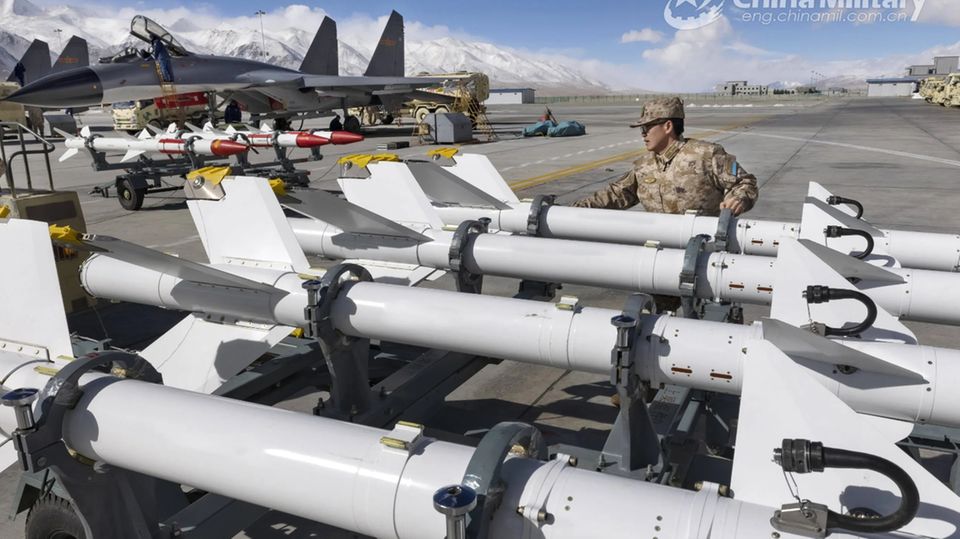War in Ukraine
Hope “Peak production” – how the West is to overtake Putin in armaments
Armaments in Russia: Uralvagonzavod assembly hall
© Uralvagonzavod
Russia’s arms machine is humming, but not for much longer. Output is expected to peak in 2024 and then decline. What speaks for this assumption, and where are the problems?
Russian armaments at a high
Nevertheless, the situation is not hopeless. Western experts believe that Russia has now reached the area of ”peak production” and that further increases are not possible. On the contrary: There could be a sharp decline in key goods such as armored vehicles of all kinds in about two years. The associated message: Ukrainian soldiers can hold out for another two years, then the situation at the front will improve.
Refurbishment and hardly any new production
What speaks for this assumption? The theory is based on the type of Russian production. Only a small proportion of armored vehicles, but also trucks, are completely new. The majority of output consists of refurbished models from stocks. No T84 or T72 is completely rebuilt; the basis is always an old model. And that is the weak point of Russian production. At some point the enormous losses will have eaten up the stocks. Then this type of refurbishment will come to an end. And before that it becomes increasingly difficult and time-consuming. At the beginning of the war, the best preserved models were taken out of storage, but over time they had to resort to increasingly poorer basic material.
The respected Royal United Services Institute (RUSI) puts it this way: “The number of systems in storage means that while Russia can maintain steady production until 2024, from 2025 onwards it will find that the vehicles require more extensive refurbishment, and by 2026 most of the available stocks will be exhausted.”
Stocks are not inexhaustible
That is at least the idea. In contrast, the Russians have large stocks. At the beginning of the war, 7,000 T72s and 3,000 T80s were stored. These models are in reserve, and there are other stocks that have already been scrapped. Russia has also begun to refurbish the T62s that have long since been abandoned, and there are probably still thousands of old models here. If you look at these figures, the basic idea that these stocks will be exhausted at some point remains correct, although the time forecast seems very optimistic.
The situation is different with highly complex systems such as modern fighter jets or surveillance aircraft. If Kiev succeeds in inflicting continuous losses on the Russians, these cannot be compensated by refurbishing old jets. If Russia is forced to completely rebuild tanks and armored personnel carriers, output will fall and costs will rise. Building completely new assembly halls and production facilities is also expensive and time-consuming. RUSI expects construction times for a grenade factory to be five years.
What does Ukraine get?
However, several factors speak against this calculation. One blind spot is Ukraine’s losses, which must be compensated for. If the Russians can add thousands more battle tanks, the question must be answered as to where Kiev will get comparable quantities.
To ramp up armaments in 2023 and 2024, the Russians were able to revive a sleeping, or rather mummified, giant. The structures and factories of the old USSR armaments industry still existed – at least in a deep sleep. After 2010, companies went bankrupt in droves or production was stopped. But these ruins could be revived, and the Russian armaments miracle was built with them.
New armaments production
That cannot be repeated, but the Russians have also recognized the problem. The most important sign of this is the new Minister of Armaments, Andrei Belousov. A capable economist, assertive technocrat and – a rarity in Putin’s empire – incorruptible. He is to ignite the second stage of the mobilization of the war economy. He leaves no doubt about his dedication. At the hearing before the appointment, he vowed to “dedicate all my strength, my health and, if necessary, my life to the fulfillment of the assigned tasks.”
A whole range of measures is necessary for this. In the area of heavy industry – bombs, grenades and armoured vehicles – an expansion of production will only be possible with new equipment. We have already had a foretaste of this with the refurbishment of the T-80 tanks, for which brand new engines have been manufactured for several months. So new production is already underway.
Analyst Patrica Marins reminds us of the cost problem. The West pays four times as much for key military equipment as the Kremlin. She writes on “X”: “The Russian advantage lies not in missiles or territorial gains, but in the fact that they have laid the foundation for a long war at low cost and by controlling the supply chains.” Neither of these can be said in the EU.
The hope for “peak production” is based on the assumption that private companies in the West are better at operating than Putin’s dirigistic state economy. This can be broken down into a simple picture. Rheinmetall must quickly build up large capacities for artillery ammunition and secure the necessary supply chains. The bet is that this project will succeed more quickly in the West than in Russia, which can rely on China’s machine tools and production know-how and existing contracts for raw materials. In addition, the armament plans for artillery ammunition in the West are based on countries like China generously increasing the supplies of the necessary raw materials. This dependency alone raises doubts about the outcome of the race.
Sources: RUSI





